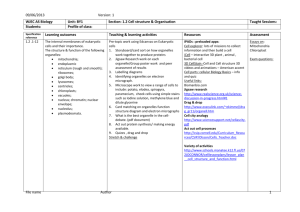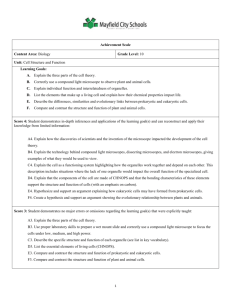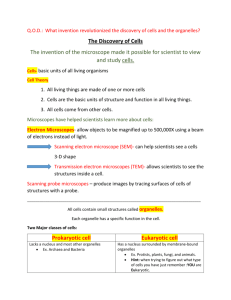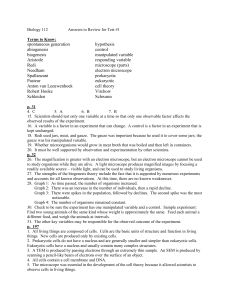Chapter 6
advertisement
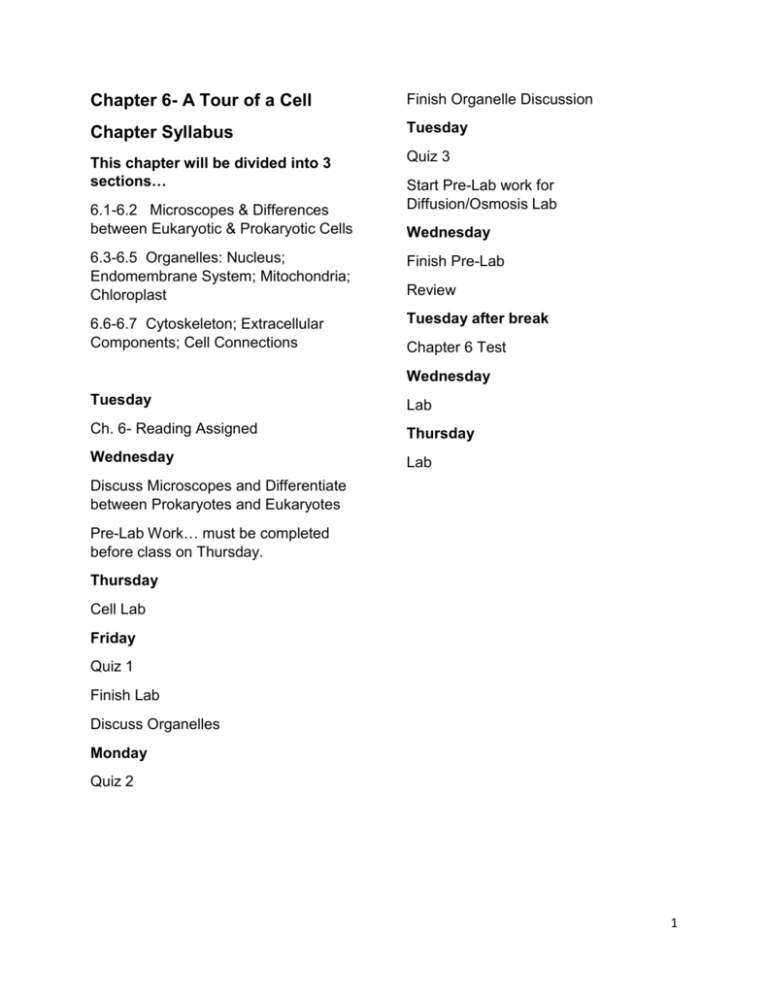
Chapter 6- A Tour of a Cell Finish Organelle Discussion Chapter Syllabus Tuesday This chapter will be divided into 3 sections… Quiz 3 6.1-6.2 Microscopes & Differences between Eukaryotic & Prokaryotic Cells Start Pre-Lab work for Diffusion/Osmosis Lab Wednesday 6.3-6.5 Organelles: Nucleus; Endomembrane System; Mitochondria; Chloroplast Finish Pre-Lab 6.6-6.7 Cytoskeleton; Extracellular Components; Cell Connections Tuesday after break Review Chapter 6 Test Wednesday Tuesday Lab Ch. 6- Reading Assigned Thursday Wednesday Lab Discuss Microscopes and Differentiate between Prokaryotes and Eukaryotes Pre-Lab Work… must be completed before class on Thursday. Thursday Cell Lab Friday Quiz 1 Finish Lab Discuss Organelles Monday Quiz 2 1 Chapter 6- A Tour of the Cell Reading Assignment: Overview: Read the overview and then answer the questions 1. All organisms are made of _________________________. 2. In biological organization, the cell is the simplest collection of _____________________ that can be alive. 3. Whether it’s a unicellular organism or a multicellular organism, the _________ is the basic unit of ______________________ and function. 4. Use the internet… a. What are the parts of the Cell Theory? b. Name the scientists credited for the Cell Theory? c. Briefly explain how the Cell Theory came about. 2 6.1 Biologists use Microscopes and the Tools of Biochemistry to Study Cells 1. When was the microscope invented? 2. In 1665, __________________________________ was the 1st person to see cell walls. ** Use the internet…What term did he use to describe what he saw through his crude microscope? __________________ Hint: we still use it today. 3. In 1674, _______________________________________________ used his lenses (microscope) to visualize living cells. 4. Light is passed through a specimen and then through glass lenses in _______________________________________ (LM). 5. In a light microscope, the lenses _________________________ or ____________________ light in such a way that the image of a specimen is magnified as it is projected into the eye or camera. 6. Define the following… a. Magnification b. Resolution c. Contrast 7. What is the greatest magnification a light microscope can have? 3 8. What is the finest resolution a light microscope has? 9. What is an organelle? 10. When was the electron microscope (EM) introduced? _________ 11. How is an Electron Microscope (EM) different from a light microscope? 12. Tell me about the resolution in an EM. 13. Explain how a Scanning Electron Microscope (SEM) works. Be sure to be complete. 14. Explain how a Transmission Electron Microscope (TEM) works. Be sure to be complete. 4 15. Give a brief description of the following types of light microscopy. a. Brightfield (unstained) b. Brightfield (stained) c. Phase contrast d. Differential-interference contrast e. Fluourescence f. Confocal g. Deconvolution h. Super-resolution 5 16. No work here… check out the micrographs on the bottom of page 96. 17. What is cytology? 18. What is biochemistry? 19. __________________________________ takes cells apart and separates the major organelles and other subcellular structures from one another. 20. Why is this technique important for studying cells? 6 21. Write out the steps of cell fractionation on the illustration below. 7 6.2 Eukaryotic Cells have Internal Membranes that Compartmentalize their Functions 1. Which 2 domains contain organisms with prokaryotic cells? 2. Which kingdoms contain eukaryotic cells? 3. These features are shared by both types of cells. Define each. a. Plasma membrane b. Cytosol c. Chromosomes d. Ribosomes 8 4. Identify and give the function of the structures of a prokaryotic cell. 5. Give the literal meaning for… a. Eukaryote b. Prokaryote 6. Describe the location of DNA in both a prokaryotic and eukaryotic cell. Make sure you denote which is which. 9 7. What is the cytoplasm of a cell? 8. Do prokaryotic cells have organelles? 9. Describe the size difference between prokaryotes and eukaryotes. 10. Complete the chart for surface area to volume ratios. 11. Why is surface area to volume ratio so important? 12. Give some ways that cells increase surface area. 10 13. Identify and give functions of both eukaryotic cells. 11 12

